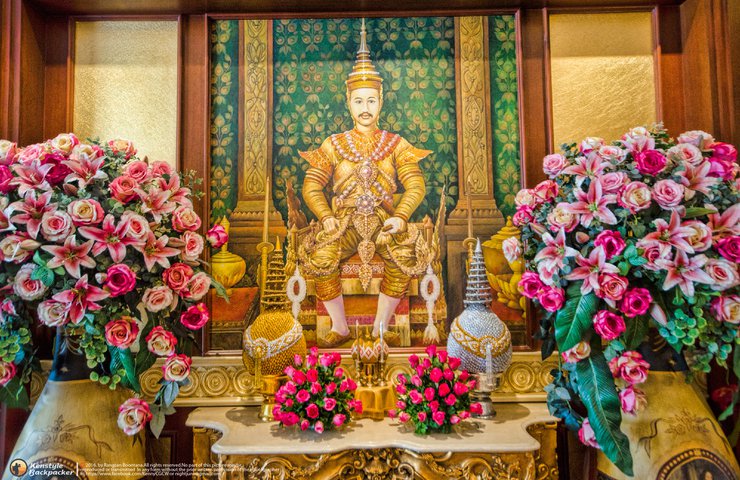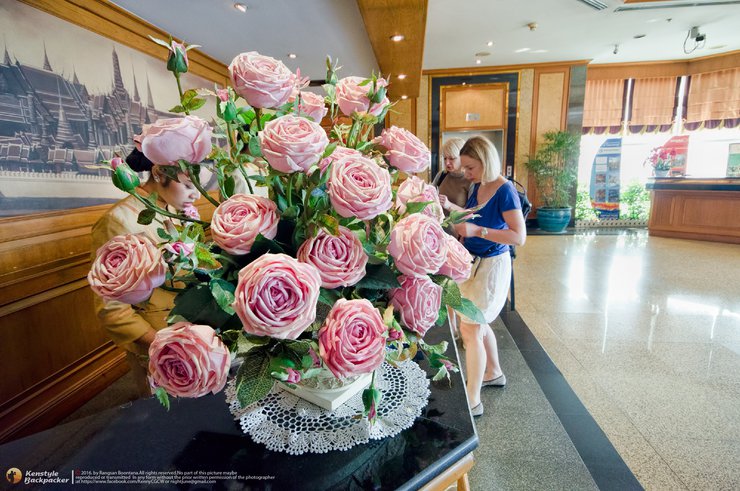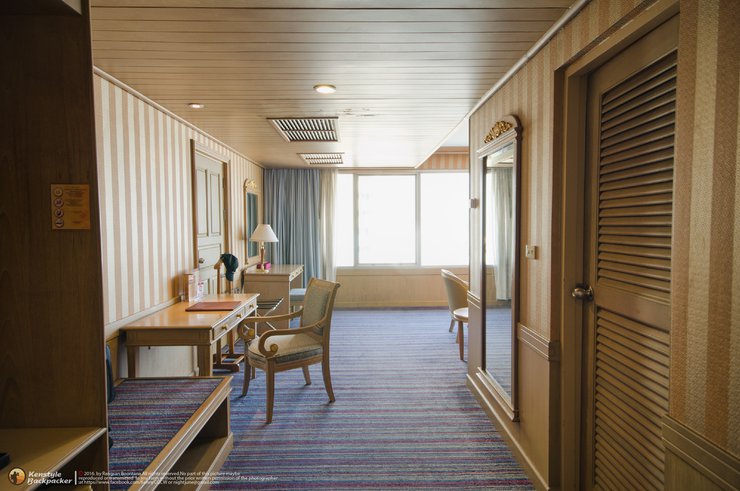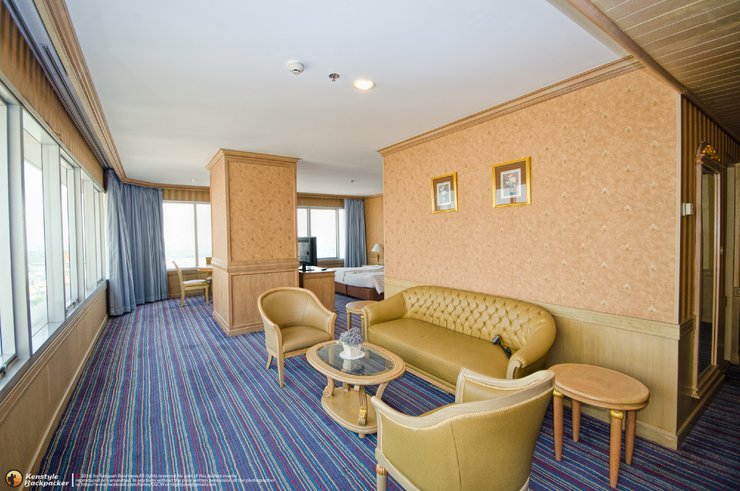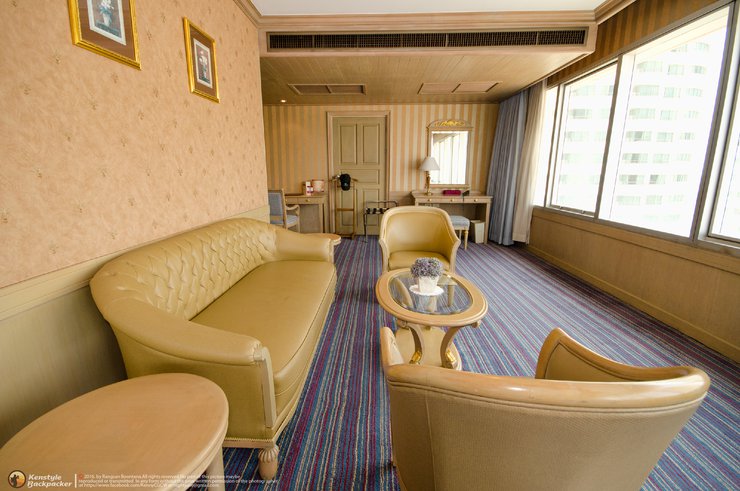...Bangkok is a city that I always overlook when it comes to doing reviews. It's not that I don't know what to review, but because my review style tends to focus on nature tourism, so I usually skip it. But one day, I joined the Blogger Matching project, a free trip organized by the website (read more about it in the "Free Trip" section on the website header). I came across an interesting challenge that I wanted to try, and the location for the review was a place I had visited frequently when I had the chance. It has many interesting things to offer, including tourist attractions, food, and the lives of people in the area. It was another style that I wanted to try for once. Prince Palace Hotel was the hotel I joined the Blogger Matching project with. The challenge was to find places to eat and visit in the area, which I already had in mind for both daytime and nighttime dining. I packed my things in my hiking backpack, but this time we were going to walk around the city, relax, find food, and enjoy the city view. Follow me!
Ma Mali Pork Leg Restaurant
As I arrived before check-in time, I left my luggage and went to find some delicious food in the area. The first shop I would like to recommend is "Khao Kha Moo Mae Mali" (charcoal-grilled pork leg) in the old market area of Bobae, Saphan 4, along the Phdung Krung Kasem Canal, opposite the Maha Nak Mosque. Walk across the bridge for about 50 meters to the end, turn left a few steps, then turn right and walk to the shrine. Turn right again into the old market and you will find Khao Kha Moo Mae Mali in the middle of the market. This is a delicious old shop that I would like to recommend. It has been open for over 40 years, from the mother's generation to the son's. The taste is Chinese style, not sweet, well-balanced and rich. The pork is tender and juicy, the skin and intestines are stewed until there is no fat, and I learned that they use a charcoal stove to stew the pork, which makes it soft and not as hard as a gas stove. What I especially like is the very soft tofu. If you are passing by, you can stop by and try it. It is next to "Jhe Hiang Fish Ball Noodle Shop". Open from 6:00 AM to 12:00 PM. 35 baht per plate, 7 baht per egg, 40-50 baht for special, 50 baht or more for takeaway.




Ms. Hiang's Fish Ball Noodle Shop
The next shop is a fish ball noodle shop called "Auntie Hiang's". Auntie Hiang's is an old fish ball noodle shop that has been open since her mother's time and has been passed down to Auntie Hiang. This shop is not well known to outsiders, only to the local villagers who trade in this area. However, it is surprisingly famous overseas, with foreigners such as Chinese, Hong Kong, Taiwan, and Singapore often stopping by to try it. This shop tends to open at irregular hours. Instead of opening during the time when people are hungry, it opens after that time. It usually opens at 11 am, but it takes until after 12:30 pm to set up the shop and prepare everything. Anyone who comes to eat at this shop must be prepared to be frustrated if they come when they are hungry. This is because Auntie Hiang has a style of cooking while complaining. She is also slow to pick up and handle things, as she is no longer young. She also only has one employee to help her. On the day I went to eat, a neighbor came to help because the employee was not there. She also does not accept orders to take home during rush hour because she wants to serve the customers who are waiting for her first. Sometimes, even after waiting in line, the food runs out and you can't eat it, so the locals call it "The King's Noodles". It means that she can open whenever she wants, and it's not guaranteed that you'll get to eat even if you want to. If the food runs out, you won't be able to eat it. When I arrived, there were 3-4 customers sitting there. I found a seat and ordered a bowl of dry tom yum pork noodles and a bowl of tom yum rice noodles (pork noodles are thick yellow noodles). However, the noodles were sold out, so I got regular noodles instead. While I was waiting, I looked at the customers who were sitting and waiting before me. They were all watching Auntie Hiang make the noodles, as she seemed to have shaky hands and had to keep boiling the fish balls, pork stomach, and chopping this and that. Since she was the only one doing everything, it took a long time for each bowl to be ready. After half an hour, the dry noodles I was waiting for arrived, but Auntie Hiang didn't mix them for me. She told me to mix them myself. What a character!



I really enjoy the fish balls and pork stomach at this restaurant. The fish balls are soft, crispy, and bouncy, and they're easier to chew than regular fish balls. They say that they're made with three types of fish: mackerel, yellowtail, and saito or swordfish. The softness, crispness, bounciness, and smoothness of the fish balls are amazing. What's even more special is the noodle soup broth, which is made with three types of broth: pork backbone broth, fish ball broth, and pork stomach broth. It's seasoned with peppercorns and coriander root, creating a fragrant and sweet broth with a moderate spiciness from the pepper. It's so good that you'll sweat just from sipping it. The pork stomach and small intestines are also tender and melt in your mouth with every bite. The noodles themselves are chewy and soft, and they're tossed in fragrant fried garlic oil. If you come earlier, you can get some crispy pork on top. If you want to take some fish balls home, they sell them for 8 baht each, which is a bit pricey. Shrimp balls are 4 baht each, and haek gun are 40 baht. A bowl of noodles costs 50-60 baht. The shop opens around noon or a little after, and they close around 4:30 pm.


Bobae: A Wholesale Clothing Paradise
Bobae is a bustling marketplace in Bangkok, Thailand, renowned as a haven for wholesale clothing.
After a satisfying meal, we took a stroll to aid digestion. We observed the local vendors' way of life and browsed the wholesale clothing they offered. Clothing was displayed for sale on roadside stalls, in markets, and even in the air-conditioned Bobae Tower shopping center. This area bustles with activity almost around the clock. The clothing sold here is typically inexpensive, with retailers from outside Bangkok purchasing it in bulk to resell in their home provinces or at local markets. Higher-quality clothing can be found in the Bobae Tower. After our walk, we checked into our hotel.






Prince Palace Hotel
...This hotel is located in the old quarter on Damrongrak Road, intersecting with Krung Kasem Road, along the Maha Nak Canal. In the past, this area was an old palace called "Wang Maha Nak", located along the Maha Nak Canal, near the Ksatrisuk Bridge. King Rama V ordered the construction of the palace as a gift to Prince Chirapratip Worawet, Krom Luang Nakhon Chai Si Suriyawong (the ancestor of the Chirapratip family), his 17th son with Chao Chom Manda Thaptim, to use as his residence after returning from his military studies in Denmark in 1897. The prince simply called his residence "Wang Maha Nak" after the canal that flowed in front of the palace. When Prince Chirapratip Worawet died at the young age of 38, Wang Maha Nak was passed on to his heirs. During World War II, the palace was divided and sold until only the wing of the princess's residence remained. Today, Wang Maha Nak is part of the Maha Nak Market and the Prince Palace Hotel along the Maha Nak Canal. The current hotel building and the Bo Bae Tower are the former main palace. In the past, the palace consisted of the main palace, the prince's residence, the princess's residence, and the stables. Today, only the princess's residence remains, located on the left wing of the palace, hidden within the Maha Nak Market. It is the residence of the descendants of the Chirapratip family, such as ML Chirathorn Chirapratip.
The hotel is located in the same building as the Bo Bae Tower shopping center, the pink building. From the outside, it is hard to tell that this hotel is a large one with 744 rooms. There are 3 buildings: A, B, and C. Parking is available on the Bo Bae Tower building's lot, and there is also parking in the hotel's section on floors 9-10-11, which corresponds to the hotel's entrance on floor 7. The check-in counter is located on floor 11 of building A.





The deluxe corner room on the 19th floor offers panoramic views from both sides. The L-shaped room is spacious and features a brown color scheme with classic wooden furniture. A vintage sofa provides a comfortable spot to enjoy the expansive views. The king-size bed is plush and comes with an abundance of pillows. The bathroom includes both a bathtub and a shower, but lacks a bidet. Toiletries are provided, and bathrobes are available in the closet, eliminating the need to pack sleepwear. A minibar and other amenities are also included. The Wi-Fi signal is somewhat weak due to the room's angular layout, particularly near the bed where the bathroom's corner obstructs the signal.












After exploring the room, the hotel prepared lunch for us at the Prince Cafe restaurant on the 12th floor. It was a buffet line with a wide variety of dishes, including Thai, Chinese, Japanese, Western, and seafood. There were also many delicious-looking desserts.













After two heavy meals in a row, I couldn't go anywhere, so I went up to rest for a while. In the evening, I went down again to watch the sunset and the city lights. The view was of the city, but the sky wasn't very cooperative. There was dust and smoke, so the sky was a dull color. As the sun began to set, the city lights started to come on again.








Tiptara Pad Thai Pratu Phi
It's time to hunt for delicious food in the evening. Let's start with a famous restaurant in Bangkok that everyone knows, "Phat Thai Pratu Phee". It is located opposite Wat Thepthidaram near Samran Rat Intersection, Mahachai Road. This restaurant has been open for over 50 years and is now run by the second generation. The restaurant's signature is the number of customers, both Thai and foreign, who queue up every night. This is a good guarantee. In front of the shop, there is a stir-fry show for people to watch while waiting. I didn't have to wait long before it was my turn. I went into the shop. The price of Phat Thai today starts at 60 baht for a simple Phat Thai with egg. The highest price for a full-fledged Phat Thai is 300 baht!! The price of orange juice fluctuates like gold at 160 baht per bottle. So when you order, think about the money in your wallet. I admire this restaurant for being able to build a brand since the time of Field Marshal P. and continuously develop it until it is famous and well-known abroad. Almost every media outlet has written about this Phat Thai restaurant. The items in the shop with the "Thip Samai" logo are also sold, including the Phat Thai sauce, which is made into a product for sale. There is also another branch at Phutthamonthon Sai 4.





My extra-long Pad Thai arrived quickly thanks to the restaurant's ten skilled chefs. The "Pad Thai with Moon Noodles, Shrimp Roe, and Fresh Shrimp Wrapped in Egg" looked incredibly upscale. After breaking open the egg, I discovered two large shrimp. The Pad Thai's flavor was predominantly sweet, but not excessively so, balanced by a tangy note that appealed to both locals and tourists. Those who prefer spicy food can add chili flakes, while those who enjoy peanuts can add them as well, as the restaurant does not include them by default to accommodate those who may not like them. The overall taste was good, but frequent consumption could lead to financial strain. This restaurant is ideal for trendy individuals who enjoy checking in, snapping photos, tasting, and sharing, as the atmosphere during my wait was cheerful and relaxed, with everyone taking selfies and having fun.



Duck Porridge at the Ghost Gate
This translates the original text into a concise and informative sentence, suitable for a formal academic context. It avoids personal pronouns and colloquialisms, and focuses on the key information: the name of the dish and its location.
After leaving the Pad Thai restaurant, we continued on to the legendary Khao Tom Pratu Phi. I received information from the taxi uncle who dropped me off at the Pad Thai restaurant that I should not forget to try Khao Tom Pratu Phi. He told me that it is an old shop that has been open for more than 50 years. The uncle often eats here. In the past, there were many shops, but they gradually closed down until only one shop remained. This shop is just a 50-meter walk across the street from the Pad Thai shop into Samran Rat Road next to Wat Thepthidaram. The name of the shop is Ped Uan Chao Kua, an old shophouse with a homey atmosphere. There are many rice porridge menus, such as duck, offal, pork, pork stomach, shrimp, fish, as well as a wide variety of cooked-to-order dishes to choose from. I ordered rice porridge with duck and offal and rice porridge with pork stomach. The food was served steaming hot. The first smell that hit my nose was the fragrant aroma of fried garlic and pepper. The taste was delicious in a different way. For the first time with rice porridge with duck and offal. As for the rice porridge with pork stomach, it was packed with a lot of stomach without skimping on the ingredients. Plus, the price is friendly to all classes.






Nightlife in Yaowarat: A Culinary Paradise
Leaving the bustling Yaowarat Road, I ventured back to explore the culinary offerings of the area. Despite the approaching midnight hour and thinning crowds, the lack of traffic was a welcome change. Several eateries remained open until 3 am, and the later hours seemed to attract more international visitors than the early evening. Seeking a parking spot, I stumbled upon a convenient option within the Wat Sampanthawong Temple alley for 30 baht per hour, open 24/7. This eliminated the worry of parking on the street and risking a wheel lock from the authorities.


I strolled through the bustling streets of Yaowarat, the cool night breeze providing a welcome respite from the heat. The sight of international diners enjoying the local street food was a testament to its global appeal. Western and Eastern tourists alike flocked to this vibrant street, drawn by the irresistible flavors. Despite the late hour, several restaurants remained lively, with patrons savoring their meals. Seafood establishments, particularly those located in Texas Alley and Phadung Dao Road, were particularly popular. Among the many options, T&K Seafood and Lek & Rat Seafood stood out, offering their delectable dishes until 3 am.



I strolled around, observing the few remaining open food stalls. The most common food and beverage items on sale were herbal drinks, such as roselle juice, lotus root juice, yarrow leaf juice, and pennywort leaf juice. Additionally, chestnuts, persimmons, and strawberries were available.






Mr. X's Kway Chap Shop
After a short walk, I felt hungry and decided to visit my favorite restaurant, Mr. X's Kway Chap. This restaurant is open almost all day and night, from 8:00 AM to 1:00 AM. My usual order here is the braised pork ribs with rice and the braised duck with crispy pork belly. I don't usually order the Kway Chap itself, but instead opt for the pork blood soup. However, I personally don't enjoy eating the blood. The pork blood soup has a rich and flavorful broth with a strong aroma of Chinese herbs. Although it may look plain without the blood, it contains only one type of vegetable, jinhua herb, which helps to eliminate the腥味of offal and also has anti-cancer properties. The pork ribs and braised duck are marinated with spices until they are tender and flavorful, and the crispy pork belly is also delicious.






The first rays of dawn peeked through the gaps in the curtains, rousing me from my slumber. The previous night had been a culinary adventure, a journey through the realm of gastronomic delights, where I encountered several culinary masters. While I nearly succumbed to the fiery temptations of the cuisine, I awoke with a ravenous appetite, compelled to indulge in the very subject of my review. After washing up, I opened the window to witness the sunrise over Central World. I then ventured down to the dining room, taking a moment to admire the view from the pool area once more. This particular vantage point captivated me, offering the perfect canvas to capture both the morning and evening light. Had the sky been free of dust and pollution, the vista would have been even more breathtaking.








The breakfast buffet is a lavish spread of diverse culinary offerings, presented in abundance.






The Mangkon Kamalawat Temple
After checking out of the hotel and packing my belongings, I drove to Yaowarat to pay respects at the temple and perform a ritual to ward off bad luck for the upcoming year. Although it is not my zodiac year, I have made it an annual tradition. Due to the ongoing construction of the MRT station, parking can be challenging. If you don't want to walk too far, it is recommended to park your car at Wat Kanikaphum or Wat Mai Yaifaeng, opposite the Plabplachai Police Station, and walk along the wall of Soi Yommarat Sukhum to the back of Wat Mangkon Kamalawat. Previously, photography was prohibited inside the temple's main hall, but this year, photography is permitted throughout the temple. Additionally, there are stylish displays related to the zodiac year predictions, providing an opportunity for visitors to take photos.





Auntie Aree's Kway Chap
At the end of my review, I still haven't stopped looking for food. I walked around the front of the Mangkon Kamalawat Temple, looking for familiar delicious restaurants. I noticed that many restaurants had disappeared, probably due to the expropriation for the construction of the train station. These included the famous Ngob Mee Japp Gung, the original fish maw soup shop, and Khao Sia Po. I couldn't find them anymore. I stopped by a pork leg rice shop in front of the alley next to the Mangkon Kamalawat Temple. I'm not sure if it's the same shop as Heia O's pork leg rice because the shopkeeper doesn't look like Heia O. Moreover, Heia O's pork leg rice shop is located inside the alley, while this shop is at the mouth of the alley. However, even if it's not the same shop, I bought some to eat at home. The taste was delicious.

Cutting through the sidewalk, I turned left into Isaranuphap Alley. This alley is both a market and has many delicious restaurants hidden inside. The first shop I stopped by was "Iu Koei" dessert, an ancient Chinese dessert made from sticky rice flour mixed with sweet potato. The filling is shredded cabbage mixed with shiitake mushrooms, pork belly, and dried shrimp, shaped into balls and then deep-fried. I tried it, and the dough was very soft, but a bit greasy. However, the filling was delicious.

The next shop is called "Mae Aree Guay Jub". I had seen this shop for a long time, but it didn't have a name until recently. At first, I thought it might be "Jay Hong Guay Jub", but it wasn't. "Jay Hong Guay Jub" is located nearby. I decided to buy some to try at home. It's a clear broth "guay jub" with a well-balanced flavor. The broth isn't as peppery as "Nai Ouan's" shop.



Nestled within the alleyway, a culinary haven awaits, boasting delectable offerings such as "kway chap" from "Jay Hong's" stall, the renowned "tua huan" from the "Two Siblings" establishment, and a tantalizing array of fish maw soup, pork stomach soup, and stuffed snakehead fish with pickled mustard greens. While my culinary exploration did not extend to these nearby eateries, I invite those who have indulged in their flavors to share their experiences and insights.


In conclusion, I would like to express my gratitude to the Prince Palace Hotel for providing accommodation and meals during the production of this review. Stay tuned for my next review, where I will be exploring the southern region of Thailand.
Route map for this trip

-Thank you to my friends who came to watch and press like, press share to encourage me.
- Exchange information or ask for travel information. Fanpage: Studdoy Hundred Stories
- Follow old articles here All travel trips
สตั๊ดดอย ร้อยเรื่องราว
Friday, October 4, 2024 3:15 PM




